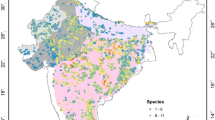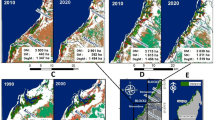Abstract
Regionalization plays an important role in delineating landscape heterogeneity and providing spatial frameworks for environmental management. In this study, we developed a comprehensive regionalization approach that integrated multiple quantitative techniques and differentiated two distinct types of landscape variables, i.e., response attributes and driving factors. This approach was applied to the regionalization of surface-water resource in the Huai River Basin (HRB), China. In the regionalization scheme, the 25 subwatersheds of the HRB were adopted as the basic spatial unit; surface-water capacity, runoff depth, and drainage system density were used to characterize surface-water distribution (i.e., response attributes). The HRB subwatersheds were classified into a certain number of groups using the k-means cluster analysis based on the three response attributes. A goodness-of-fit index, calculated as the ratio of between-group/within-group variation, was employed as a quantitative criterion to assess the statistical performance of the classification results. Ultimately, the 25 subwatersheds were partitioned into five distinct regions. Results from redundancy analysis suggested that such regional pattern of surface-water resource was primarily correlated with driving factors representing climate conditions; soil and geological properties also had significant influences. Overall, our approach presents two advantages over previous regionalization frameworks: (1) It improves objectivity of landscape regionalization and reveals underlying mechanisms, generating landscape patterns by integrating response attributes and driving factors; (2) Goodness-of-fit evaluation can substantially reduce subjectivity in determining regionalization results.








Similar content being viewed by others
References
Abell R, Thieme ML, Revenga C et al (2008) Freshwater ecoregions of the world: a new map of biogeographic units for freshwater biodiversity conservation. Bioscience 58:403–414
An S, Li H, Guan B, Zhou C, Wang Z, Deng Z, Zhi Y, Liu Y, Xu C, Fang S, Jiang J, Li H (2007) China’s natural wetlands: past problems, current status, and future challenges. Ambio 36:335–342
Bailey RG (1983) Delineation of ecosystem regions. Environ Manage 7:365–373
Bernert JA, Eilers JM, Sullivan TJ, Freemark KE, Ribic C (1997) A quantitative method for delineating regions: an example for the western Corn Belt plains ecoregion of the USA. Environ Manage 21:405–420
Bhat G, Bergstrom J, Teasley RJ, Bowker JM, Cordell HK (1998) An ecoregional approach to the economic valuation of land- and water-based recreation in the United States. Environ Manage 22:69–77
Bryce SA, Clarke SE (1996) Landscape-level ecological regions: linking state-level ecoregion frameworks with stream habitat classifications. Environ Manage 20:297–311
Csillag F, Kabos S (2002) Wavelets, boundaries, and the spatial analysis of landscape pattern. Ecoscience 9:177–190
Fairbanks DHK, Benn GA (2000) Identifying regional landscapes for conservation planning: a case study from KwaZulu-Natal, South Africa. Landsc Urban Plan 50:237–257
Fortin M, Dale MRT (2005) Spatial analysis. Cambridge University Press, Cambridge
Gallant AL, Loveland TR, Sohl TL, Napton DE (2005) Using an ecoregion framework to analyze land-cover and land-use dynamics. Environ Manage 34:S89–S110
Gamble A, Babbar-Sebens M (2012) On the use of multivariate statistical methods for combining in-stream monitoring data and spatial analysis to characterize water quality conditions in the White River Basin, Indiana, USA. Environ Monit Assess 184:845–875
Gordon AD (1999) Classification. Chapman & Hall/CRC, London
Graef F, Schmidt G, SchrÖder W, Stachow U (2005) Determining ecoregions for environmental and GMO monitoring networks. Environ Monit Assess 108:189–203
Guo J, Gao S, Wang G, Mao F, Li Y, Zhuang L (2001) China’s cloud water resource and soil water resource. Climate Press, Beijing
Hall O, Arnberg W (2002) A method for landscape regionalization based on fuzzy membership signatures. Landsc Urban Plan 59:227–240
Hargrove WW, Hoffman FM (1999) Using multivariate clustering to characterize ecoregion borders. Comput Sci Eng 1:18–25
Hargrove WW, Hoffman FM (2005) Potential of multivariate quantitative methods for delineation and visualization of ecoregions. Environ Manage 34:S39–S60
Host GE, Polzer PL, Mladenoff DJ, White MA, Crow TR (1996) A quantitative approach to developing regional ecosystem classifications. Ecol Appl 6:608–618
Itsukushima R, Shimatani Y, Kawaguchi Y (2013) The effectiveness of delineating ecoregions in the Kyushu region of Japan to establish environmental indicators. Landsc Ecol Eng 9:27–46
Jenerette GD, Lee J, Waller DW, Carlson RE (2002) Multivariate analysis of the ecoregion delineation for aquatic systems. Environ Manage 29:67–75
Johnston R (1968) Choice in classification: the subjectivity of objective methods. Ann Assoc Am Geogr 58:575–589
Kreft H, Jetz W (2010) A framework for delineating biogeographical regions based on species distributions. J Biogeogr 37:2029–2053
Leathwick JR, Overton J, McLeod M (2003) An environmental domain classification of New Zealand and its use as a tool for biodiversity management. Conserv Biol 17:1612–1623
Lepš J, Šmilauer P (2003) Multivariate analysis of ecological data using CANOCO. Cambridge University Press, Cambridge
Liu M, Samal A (2002) A fuzzy clustering approach to delineate agroecozones. Ecol Model 149:215–228
Loveland TR, Merchant JM (2005) Ecoregions and ecoregionalization: geographical and ecological perspectives. Environ Manage 34:S1–S13
Lugo AE, Brown SL, Dodson R, Smith TM, Shugart HH (1999) The Holdridge Life Zones of the conterminous United States in relation to ecosystem mapping. J Biogeogr 26:1025–1038
Mackey BG, Berry SL, Brown T (2008) Reconciling approaches to biogeographical regionalization: a systematic and generic framework examined with a case study of the Australian continent. J Biogeogr 35:213–229
McMahon G, Gregonis SM, Waltman SW, Omernik JM, Thorson TD, Freeouf JA, Rorick AH, Keys JE (2001) Developing a spatial framework of common ecological regions for the conterminous United States. Environ Manage 28:293–316
McMahon G, Wiken EB, Gauthier DA (2005) Toward a scientifically rigorous basis for developing mapped ecological regions. Environ Manage 34:S111–S124
Milligan GW, Cooper MC (1985) An examination of procedures for determining the number of clusters in a data set. Psychometrika 50:159–179
Olson DM, Dinerstein E, Wikramanayake ED, Burgess ND, Powell GVN, Underwood EC (2001) Terrestrial ecoregions of the world: a new map of life on Earth. Bioscience 51:933–938
Omernik JM (1987) Ecoregions of the conterminous United States. Ann Assoc Am Geogr 77:118–125
Omernik JM (2005) Perspectives on the nature and definition of ecological regions. Environ Manage 34:S27–S38
Omernik JM, Bailey RG (1997) Distinguishing between watershed and ecoregion. J Am Water Res Assoc 33:935–949
Snelder TH, Dey KL, Leathwick JR (2007) A procedure for making optimal selection of input variables for multivariate environmental classifications. Conserv Biol 21:365–375
Stoddard JL (2005) Use of ecological regions in aquatic assessments of ecological condition. Environ Manage 34:S61–S70
Ter Braak CJF, Smilauer P (1998) CANOCO Reference Manual and user’s guide to Canoco for Windows: Software for Canonical Community Ordination (version 4). Microcomputer Power, Ithaca
Wang S, Dou H (1998) Lakes of China. Science Press, Beijing
Wolock DM, Winter TC, McMahon G (2005) Delineation and evaluation of hydrologic-landscape regions in the United States using geographic information system tools and multivariate statistical analyses. Environ Manage 34:S71–S88
Zhou Y, Narumalani S, Waltman WJ, Waltman SW, Palecki MA (2003) A GIS-based spatial pattern analysis model for eco-region mapping and characterization. Int J Geogr Inf Sci 17:445–462
Acknowledgments
We thank two anonymous reviewers for their valuable comments on an earlier version of this paper. This study was supported by the Major Science and Technology Program for Water Pollution Control and Treatment (2012ZX07501002-003), Special Environmental Protection Project of Public Interests (201009009-04-03), and National Natural Science Foundation of China (41271197).
Author information
Authors and Affiliations
Corresponding author
Rights and permissions
About this article
Cite this article
Xu, C., Sheng, S., Chi, T. et al. Developing a quantitative landscape regionalization framework integrating driving factors and response attributes of landscapes. Landscape Ecol Eng 10, 295–307 (2014). https://doi.org/10.1007/s11355-013-0225-8
Received:
Revised:
Accepted:
Published:
Issue Date:
DOI: https://doi.org/10.1007/s11355-013-0225-8




